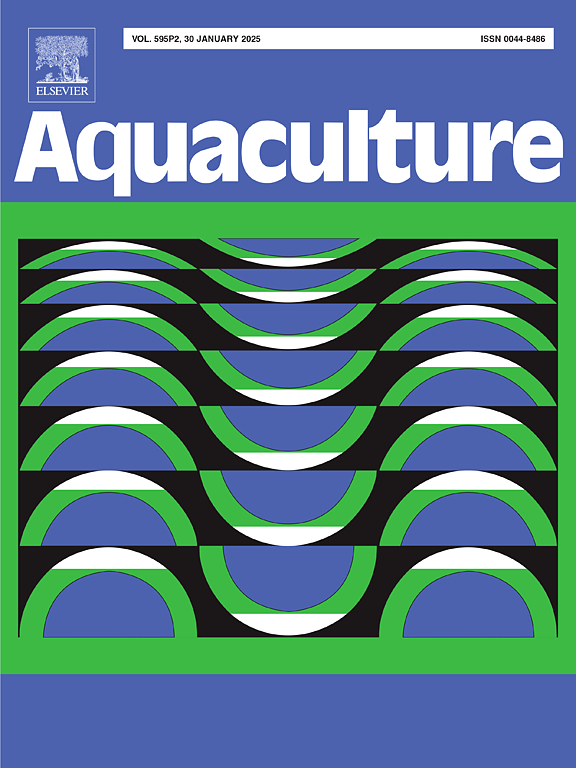Validation of QTL associated with resistance to Lernanthropus kroyeri in European seabass
IF 3.9
1区 农林科学
Q1 FISHERIES
引用次数: 0
Abstract
Lernanthropus kroyeri constitutes the most commonly encountered parasitic copepod for European seabass (Dicentrarchus labrax). Infection of gills with copepods directly impacts fish survival and growth performance with further economic implications for the aquaculture industry. Earlier studies identified moderate heritability of parasite count and two suggestive candidate QTL that explained 2 % of the total phenotypic variance each. The present study focuses on the two previously identified QTL loci to validate any QTL effect on L. kroyeri parasite resistance. In order to facilitate the validation of healthy and infected fish, individuals were selected based on their resistance to parasites, specifically the presence or absence of L. kroyeri in fish reared in a standard open sea cage. A subset of samples was genotyped using the 30 k MedFISH SNP array and the putative QTL effects were tested for parasite resistance by fitting an animal model in ASREML-R while the AIC criterion was used to assess model fit. The p-values for the two SNP with highest association to parasite resistance AX-373127007 and AX-373218583 were 0.041 (<0.05) and 0.085 (<0.1), respectively. Despite the moderate significance of the second SNP, the lowest AIC score was detected after using both SNPs as fixed effects in the animal model. The findings of the present study, using a different population, validate the important role of the detected QTL loci on parasite resistance, highlighting a possible application of a low-cost Marker Assisted Selection (MAS) breeding program in farmed European seabass populations.
欧洲鲈鱼对克氏弧菌抗性相关QTL的验证
克氏Lernanthropus kroyeri是欧洲海鲈(Dicentrarchus labrax)最常见的寄生桡足类。桡足类动物感染鳃直接影响鱼类的生存和生长性能,并对水产养殖业产生进一步的经济影响。早期的研究确定了寄生虫数量的中等遗传力和两个暗示的候选QTL,每个QTL解释了总表型变异的2%。本研究的重点是先前鉴定的两个QTL位点,以验证QTL对克氏乳杆菌寄生虫抗性的影响。为了便于对健康鱼和受感染鱼进行验证,根据其对寄生虫的抵抗力,特别是在标准远洋网箱中饲养的鱼中是否存在克氏杆菌来选择个体。使用30 k MedFISH SNP阵列对样本进行基因分型,并通过ASREML-R拟合动物模型来检验推测的QTL效应对寄生虫抗性的影响,同时使用AIC标准来评估模型的拟合。AX-373127007和AX-373218583与寄生虫抗性相关性最高的两个SNP的p值分别为0.041 (<0.05)和0.085 (<0.1)。尽管第二个SNP具有中等意义,但在动物模型中使用这两个SNP作为固定效应后,检测到的AIC评分最低。本研究利用不同种群,验证了检测到的QTL位点对寄生虫抗性的重要作用,强调了低成本标记辅助选择(MAS)育种计划在养殖欧洲鲈鱼种群中的应用可能性。
本文章由计算机程序翻译,如有差异,请以英文原文为准。
求助全文
约1分钟内获得全文
求助全文
来源期刊

Aquaculture
农林科学-海洋与淡水生物学
CiteScore
8.60
自引率
17.80%
发文量
1246
审稿时长
56 days
期刊介绍:
Aquaculture is an international journal for the exploration, improvement and management of all freshwater and marine food resources. It publishes novel and innovative research of world-wide interest on farming of aquatic organisms, which includes finfish, mollusks, crustaceans and aquatic plants for human consumption. Research on ornamentals is not a focus of the Journal. Aquaculture only publishes papers with a clear relevance to improving aquaculture practices or a potential application.
 求助内容:
求助内容: 应助结果提醒方式:
应助结果提醒方式:


